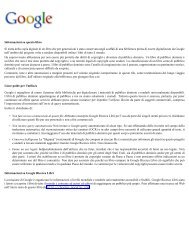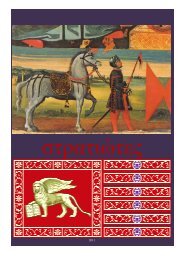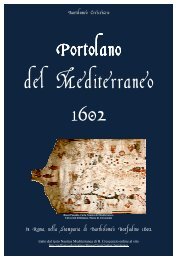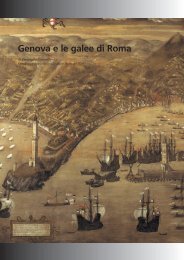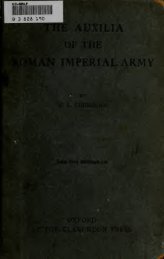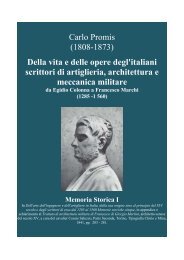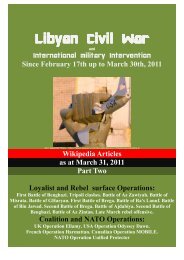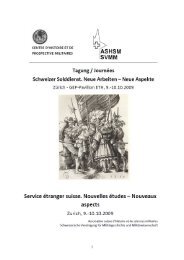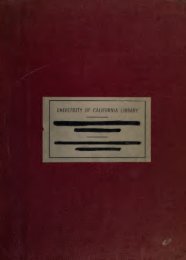66making them, apparently for use in making additionalsamples.""'Commimication on the subject between Meigsand Sherman continued with the QuartermasterGeneral rather neatly summing up the whole matter:"The present cavalry officer's helmet is of feltand weighs lOi/g ounces complete [while] the presentofficer's cap is cloth covered pasteboard andweighs 714 ounces." Meigs then went on to say thatthe helmet asked for in the petition was that recommendedby the Miles Board and weighed 1714ounces for the mounted article. "You have signifiedthat you will approve a black felt helmet properlyventilated," he continued, "as soon as one canbe invented that won't weigh down the wearer ....As the outward appearance of the officer's helmetas an article of uniform is all that directly concernsthe government (since they buy their own) willit not be sufficient to adopt some pattern and colorleaving the material to be selected by the officerhimself? . . If the officers generally desire thechange, will it not be well to indulge them? Wheneverthe officers get a helmet, petitions to give thesame to the enlisted men will be in order and mustbe met. But in the meantime actual trials and experienceof officers will probably develop the bestmaterial and pattern." """ The tone of this letterleads one to believe that Meigs was plumping foradoption of the helmet for enlisted personnel aswell as officers, and if this is what he intended, hewas successful, for several days later Sherman approvedthe change for the whole <strong>Army</strong> and directedMeigs to draft a general order for submission to theSecretary of War.""Meanwhile Meigs continued to press Rogers forthe additional samples then being made and a goodbit of confusion resulted, which was not resolvedfor several months.""" On 16 December, Rogers forwardedfour helmets made by several manufacturerswith a long letter describing them, their prices,and a general discussion of their possible ornaments,making a particular point of saying that inorder to insure uniformity, the government shouldprocure and own the dies for the metal trimmings,to be loaned to manufacturers, a point on whichMeigs agreed.""" On 27 December Meigs forwardedto Sherman his draft of the general order on thehelmets which was in turn published as GeneralOrder No. 4, Headquarters of the <strong>Army</strong>, 7 January1881. •'""SMITHSONIAN STUDIES IN HISTORY AND TECHNOLOGYBy direction of the Secretary of War the following modificationsin the uniform of the <strong>Army</strong> are made:I. The dress cap for regimental officers and men will bediscontinued and in lieu thereof the following adopted:Helmets for field officers.—According to the pattern onfile in the office of the Quartermaster General. Body: ofcork or other suitable material covered with black cloth, orof black felt at the option of the wearer. Trimmings: cordsand tassels, top piece and plume-socket, chain chin-strapand hooks, eagle with motto, crossed cannon, rifles, or sabres,all gilt, with the number of the regiment on the shield inwhite; plume of buffalo-hair, white for infantry, yellow forcavalry, and red for artillery.Helmets for other officers of mounted troops and of SignalCorps.—Ssime as above, except that color of plume shall beorange for Signal Corps.Helmets for other officers of foot troops.—Same as above,except that the trimmings are as follows: Top piece, spike,chin-strap with hooks and side buttons, eagle with motto,cross rifles or cannon, all gilt, with the number of the regimenton the shield in white.Officers' summer helmets.—Body: of cork as per patternin the office of the Quartermaster General, covered withwhite facing-cloth; top piece, spike, chain chin-strap, andhooks, all gilt.Helmets for all mounted troops.—Body: of black felt asper pattern in the office of the Quartermaster General, withleather chin-strap, large crossed cannon or sabers, letter ofcompany and number of regiment, plain side buttons, toppiece and plume-socket, all brass; horse-hair plumes andcords, and band with rings of the color of the arm of service.Helmets for all foot troops.—Of same pattern and materialas for mounted troops, with leather chin-strap; andplain side buttons, top piece and spike, of brass.Trimmings.—Commissary sergeants, a crescent of whitemetal; hospital stewards, a wreath of brass, with lettersU. S. in white metal; engineers, a castle, with letter ofcompany; ordnance, a shell and flame; artillery, crossed cannon;infantry, crossed rifles, and letter of company andnumber of regiment, all in brass.The allowance of helmets will be one in the first andone in the third year of enlistment.This order will go into effect, except for cavalry and lightbatteries, on the 1st of July next or as soon thereafter asthe supplies can be procured by the Quartermaster's Department;for cavalry and light batteries whenever the presentstock of helmets is exhausted by issues.A new price-list and table of allowances, based uponthese changes, will be promulgated by the time this ordergoes into effect.Officers may use the new helmet immediately if they sodesire.Following the publication of the order, Meigshad the approved samples photographed and thepictures rather widely distributed.^"' Several dayslater he forwarded to Philadelphia the sampleadopted for enlisted men with instructions to procurefour similar models for use as sealed samples
NUMBER 30 67to be sent to Washington together with specificationsfor the same.*"' It should be noted here thatbecause of the confusion over the samples, whichwas to increase over the next several weeks, thespecifications were not drafted until much later,finally being published in May after a number ofchanges had been made. On 14 January, Rogerswrote Meigs for information as to the officers' helmetsand asked that the models that had beenadopted be sent to him."" Meigs replied in a ratherinvolved letter that, as will be seen, served to confusethe Philadelphia Depot even more. The QuartermasterGeneral stated that he was returning thesix helmets recommended by the Miles Board, twoof which had been adopted for officers (that forfield and mounted officers and the officer's summerhelmet), and made the point that Sherman particularlydesired that the helmets be uniform inshape. He inclosed a set of the helmet photographs.***The confusion became complete with the publicationof the 22 January issue of the <strong>United</strong> <strong>States</strong><strong>Army</strong> and Navy Journal, which carried a featurearticle, including illustrations made from six of theseven photographs of the approved patterns. Evena cursory glance indicates the confusion: The approvedpatterns were not all of one shape; the selectionincluded helmets both from the MilesBoard samples and the four furnished by Rogers;and the brass trimmings differed between officers'and enlisted models and between foot and mountedofficers. The pattern for enlisted men, althoughquite similar to that selected by the Miles Board(as shown in the drawings), was apparently patternedon one of Rogers' four models in that itcarried a pin-wheel ventilator on either side, inaddition to crossed cannon without an eagle for afront plate, plus a spike base taken from the 1872helmet (Figures 46, 47) .*" It should be noted, however,that the side buttons carried the branch ofservice device as in the Miles Board drawings. Thatfor foot officers was from the Rogers models as opposedto the Miles Board helmets in that the shapewas distinctly different, the spike base was againFIGURE 46.—Officers' helmets: a, officers of foot troops(note shape and model 1872 spike base); b, field officers'helmet with spike (note shape and "tiger head" side buttons); c, summer helmet (note shape and "tiger head" sidebuttons).
- Page 1:
• ^ - :lP-'L^ry\'^ ^iT
- Page 4 and 5:
ABSTRACTHowell, Edgar M. United Sta
- Page 7 and 8:
ContentsPagePrefaceiiiThe 1855 Cava
- Page 9 and 10:
United States Army Headgear 1855-19
- Page 11 and 12:
NUMBER 30report, stated: "The hat p
- Page 13 and 14:
NUMBER 30acorns %g inches long and
- Page 15 and 16:
NUMBER 30the pattern." The rate of
- Page 17 and 18:
NUMBER 30FIGURE 3.—1858 Army hat.
- Page 19 and 20:
NUMBER 3011model, number 60 in the
- Page 21 and 22:
NUMBER 30 13"the desired modificati
- Page 23 and 24: NUMBER 30 15the sun in the top. The
- Page 25 and 26: NUMBER 30 17FIGURE 8.—1858 forage
- Page 27 and 28: NUMBER 30 19Hardtack and Coffee, ca
- Page 29 and 30: NUMBER 3021FIGURE 11.—a, Brigadie
- Page 31 and 32: NUMBER 30 23short "shell" jacket "f
- Page 33 and 34: NUMBER 30 26broad, securely soldere
- Page 35 and 36: NUMBER 30 27worn in the picture wer
- Page 37 and 38: NUMBER 30 29This communication elic
- Page 39 and 40: NUMBER 30 31FIGURE 17.—"The [Scot
- Page 41 and 42: NUMBER 30 33time for issue in the c
- Page 43 and 44: NUMBER 30 35be at too great a dista
- Page 45 and 46: NUMBER 3037half (5/2) part of washb
- Page 47 and 48: NUMBER 30 39trimmings for all enlis
- Page 49 and 50: NUMBER 30 41ing the upper space for
- Page 51 and 52: NUMBER 30rear one to a correspondin
- Page 53 and 54: NUMBER 30 46FIGURE 29.—1872 enlis
- Page 55 and 56: NUMBER 3047FIGURE 32.—^The Bent &
- Page 57 and 58: NUMBER 3049of strong split-leather
- Page 59 and 60: NUMBER 30 51''""MttfenFIGURE 35.—
- Page 61 and 62: NUMBER 30 53(which he thought might
- Page 63 and 64: NUMBER 30 55FIGURE 38.—Captain Be
- Page 65 and 66: NUMBER 30 57campaign hat for the Ar
- Page 67 and 68: NUMBER 30 59salvage something from
- Page 69 and 70: NUMBER 30 61hat. In June 1899 the P
- Page 71 and 72: NUMBER 3063the left side, pass diag
- Page 73: NUMBER 30 65.LJU^.."*^..FIGURE 44.
- Page 77 and 78: NUMBER 30 69with brass sliding-buck
- Page 79 and 80: NUMBER 30 71FIGURE 48.—Officers'
- Page 81 and 82: NUMBER 3073The adoption of the whit
- Page 83 and 84: NUMBER 3075i >•^\Wiii I ifiiiniim
- Page 85 and 86: NUMBER 30this last model made no pr
- Page 87 and 88: NUMBER 30 79WAR DEPARTMENT,QUARTERM
- Page 89 and 90: NUMBER 3081FIGURE 58.—1864 chapea
- Page 91 and 92: NUMBER 30geon 1880 and Surgeon Gene
- Page 93 and 94: NUMBER 3085FIGURE 63.—1895 forage
- Page 95 and 96: NUMBER 30 87of not less than 9.24 g
- Page 97 and 98: AppendixMAKERS OF HEADGEARThe chron
- Page 99 and 100: List of AbbreviationsAAGAAQMAGAGOAQ
- Page 101 and 102: NUMBER 3093all OQMG, LS, Clothing,
- Page 103 and 104: NUMBER 30 95"Jesup to Thomas, 8 Dec
- Page 105 and 106: NUMBER 3097OQMG, Reg. LR, Clothing,
- Page 107 and 108: NUMBER 30 99October of 1870. See Me
- Page 109 and 110: NUMBER 30 101'"* See above, pp. 35-
- Page 111 and 112: NUMBER 30 103Monroe, Va., in 1878.
- Page 113 and 114: NUMBER 30 105""Endorsement, 24 May
- Page 115 and 116: ReferencesThe bulk of the source ma
- Page 117: M MBIiR 30 10910, No. 355-10, 19 Se



